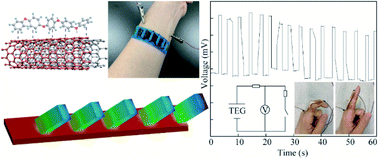A gill-mimicking thermoelectric generator (TEG) for waste heat recovery and self-powering wearable devices†
Abstract
A waste heat recovery unit can transfer heat at high temperatures to another energy form for specific purposes with increasing energy efficiency. The heat recovered from nature or human body systems for generating electricity or powering wearable devices is a good example of green and sustainable power sources. Currently available thermoelectric generators (TEGs) can convert heat into electricity. However, they lack mechanical flexibility and specially designed structures to efficiently harvest energy from low temperature (≤100 °C) surfaces, e.g., hot water pipes, car roofs, or human skin. Here, we report bottom-up manufacturing that scaled up molecular-level polymer-nanoparticle hybridization to device-level units, thus bridging nanoscale material interactions to macroscale energy conversion efficiency. In situ polymerization optimized the interface between polyaniline (PANi) and multi-walled carbon nanotubes (MWNTs) to reach a higher power factor (i.e., ∼1.25 μW m−1 K−2) than the directly mixed PANi/MWNT samples (i.e., ∼0.8 μW m−1 K−2), both with a high nanotube concentration of 58.7 wt%. With a rapidly prototyped thermoplastic polyurethane (TPU) substrate, the PANi/MWNT hybrids formed a bio-inspired, gill-mimicking, and flexible thermoelectric generator (fTEG). These out-of-plane structures with PANi/MWNTs as gills showed highly efficient energy transformation on the surfaces of hot water containers (∼100 °C), car roofs (∼38 °C), and human skin (∼37 °C). The PANi/MWNT fTEG showed excellent mechanical durability with improved stiffness and strength than pure PANi, fatigue resistance, and bendability most appropriate for powering wearable sensors. With a strain switch, the fTEG is able to power a sensing system that reveals biosignals, such as joint movement and respiration, in the long term. The self-powered sensing system applies to wearable smart devices and demonstrates the potential for using the thermoelectric effect as an alternative power source.



 Please wait while we load your content...
Please wait while we load your content...